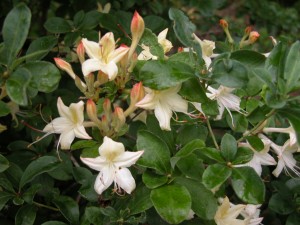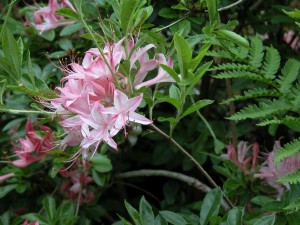Swamp Azalea (Rhododendron viscosum, formerly R. serrulatum) is very different among deciduous azaleas. Most rhododendrons (azaleas) do not care for soppy, poorly drained soils. This U.S. native is an exception, indigenous to swamps, bogs, stream edges and wet lowlands from southern Maine to northeastern Ohio south to Florida and Alabama. Add that it is also exceptionally winter hardy (USDA hardiness zones 4-9). If your property has a stream, pond, or leach field, this species is a good choice.
Swamp azalea grows 8-10 feet tall and 6-8 feet wide. It is an early summer bloomer with abundant long tubular flowers that some might confuse as wild honeysuckle (Lonicera spp.). Its spicy, clove-scent fills the late June-July garden air and attracts butterflies and hummingbirds. The 1 to 2 inches long white flowers are sticky to the touch. Pale pink and lemon yellow forms can be observed in the wild.
Two-year old established plants are highly drought tolerant. The glossy green summer foliage is highly disease and pest resistant; some wild forms emerge with bluish green leaves in the spring. All plant parts are poisonous and deer usually keep their distance. Among the native deciduous azaleas, swamp azalea’s flame red foliage color is exceptional. Pruning is best after flowering to manage plant height and spread.
Swamp azalea is best grown in acidic (pH range between 5.0 – 6.0), compost-rich, well-drained soil and under partial shade. Full morning sunlight in northerly zones (zones 4-7) is adequate. Some seaside selections are very salt tolerant, and is best sited away from strong winter winds.
Roots are fibrous and grow near the soil surface. They benefit from annual mulching (wood chips or pine bark or needles). Plants slowly naturalize from root suckers.
Cultivar list includes ‘Lemon Drop’ , ‘Parade’, ‘Pink Mist’ , ‘Pink Rocket’ among others.



 Posted in
Posted in 
